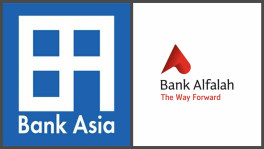Digitalizing Bangladesh: How far are we?
Digital inequality, which prevents marginal groups, e.g, women and the poor, from taking advantage of digitalization, was a major topic of the conference

Rima (not her real name) had just completed her HSC when her elder brother advised her to utilize her free time and learn some skills.
So, she practiced on her brother's laptop since she did not have her device. Her brother also trained her on some soft skills and currently, Rima has become an independent freelancer, serving clients across the world.
"Freelancing gives me the flexibility to continue my higher studies along with my work. During my exams, I don't take any projects. I use all my vacations for my work. Also, I use the money to pay my tuition fees," Rima exclaimed.
Rima is one of those 500,000 active freelancers who reside and provide services to global clients from Bangladesh. But, she also represents only 9% of women who are involved in freelancing in Bangladesh. Why is the number so low? And, how can we increase their participation?
This is one of the topics discussed in the international conference "Digitalization and New Frontiers of Service Delivery: Opportunities and Challenges" organized by BRAC Institute of Governance and Development (BIGD), BRAC University from June 20-22 in Dhaka.

Freelancing was discussed on the second day of the conference. The session discussed the results of a randomized control trial (RCT) that measured the impact of a four-month training on freelancing for underprivileged young women. The results revealed a significant rise in employment and income, indicating the potential of such training in improving women's participation in freelancing.
A couple of other sessions discussed the status of the digital capacity of our population and the existing digital inequalities, which also shed light on the reasons for women's low participation in freelancing. The main reason is probably the reluctance of families to allow their daughters to use smartphones and access the internet [which is evident from the low number of girls from rural and urban slums attending online classes during Covid-19]. As a result, women are less likely to have the family support, confidence, and necessary digital literacy to take advantage of freelancing, speakers said at the conference.
The overall objective of the conference was to bring researchers, practitioners, and policymakers from around the world to share learnings and experiences on the ways to use digitalization for inclusive development. Digital inequality, which prevents marginal groups, e.g, women and the poor, from taking advantage of digitalization, was a major topic of the conference. The other topics focused on the technical, political, bureaucratic, and social challenges of utilizing digitalization for inclusive development as well as opportunities and possible solutions.

Imran Matin, executive director of BIGD, said there was a real potential to improve governance and development outcomes in Bangladesh through digitalization. But that would require real collaboration between the social scientist and practitioners and technical experts to develop digital solutions, critical analysis and sharing of learnings, and acting on the global and local learning to design a digital solution that is inclusive and welfare-enhancing.
In his keynote speech, Stefan Dercon, a professor of economic policy at the University of Oxford, pointed out that improving the existing services is just one aspect of digitalization and cited global experience on how it is creating new economic opportunities in the global South. He explains how digital technology transforms the ways goods and services are produced, consumed, and exchanged, leading to changes in business, government, and society as a whole. He discussed the risks involved in the process of this transformation: lack of proper and timely regulation of innovations, exclusion of different groups, and the inertia or excessive involvement of the state in industrial policy, which may result in monopolistic power or an undesirable business models that are hard to change. He suggests that the starting point is to develop a thorough understanding of the bureaucratic politics, special interests, and the underlying elite commitments to use digitalization for economic progress and inclusion.
Speaking about the achievements, future challenges, and opportunities of digitalization in Bangladesh, Anir Chowdhury, policy advisor to a2i, highlighted how the strong commitment of the government leadership has transformed the use of digital technology for development. He stressed that between 2008 and now, internet connectivity increased from less than 1% to 65% of the population, and digital services increased from 10 to 1,500. He shared some of the critical learning of a2i over the years, for example, the importance of demonstration effect, areas of effective private-public partnership, and the strategies for encouraging innovation.

In one session, the speakers took the case of online birth registration to reflect on the various types of challenges citizens, especially marginal people, may face in accessing digital services of a similar type.
In several sessions, speakers discussed the implications, both opportunities, and pitfalls, of digitalizing the social safety net, health, and education services.
Another session focused on the platform services like Uber and Pathao. The speakers in this session shed light on the opportunities and challenges in these emerging sectors—working conditions, labour rights, and structural changes in the labour market, for example.
There was a session on the learnings from digitalization during the COVID-19 pandemic, particularly focusing on delivering education through digital and hybrid methods to marginal groups like children coming from lower socioeconomic backgrounds and children with disability.
Politics, governance, bureaucracy, and power dynamics—these aspects of digitalization were another important strand of the conference. The speakers focused on the conditions necessary as well as possible strategies to navigate and take advantage of the status quo towards the goal of digitalization for inclusive development.
The three-day conference came to an end with a commitment from the policymakers, practitioners, and researchers alike to work together towards the goal of using digitalization to make lives better for all citizens.


 Keep updated, follow The Business Standard's Google news channel
Keep updated, follow The Business Standard's Google news channel
















